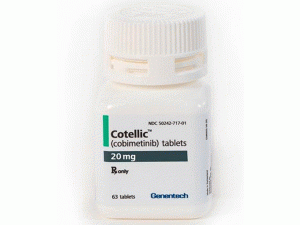考比替尼片COTELLIC 20MG TAB(cobimetinib)
 药店国别:
产地国家:美国
处方药:是
所属类别: 20毫克/片 63片/瓶
包装规格: 20毫克/片 63片/瓶
计价单位:瓶
生产厂家中文参考译名:
生产厂家英文名:Genentech
原产地英文商品名:COTELLIC Tablets 20mg/tab 63tabs/bottle
原产地英文药品名:cobimetinib
中文参考商品译名:Cotellic口服片 20毫克/片 63片/瓶
中文参考药品译名:考比替尼
曾用名:
简介:靶向抗癌新药Cotellic(cobimetinib)获美国FDA批准,联合罗氏自身已上市抗癌药Zelboraf(vemurafenib,威罗菲尼),用于BRAF V600E或V600K突变阳性不可切除性或转移性黑色素瘤患者的治疗。FDA的药品评价和研究中心中血液学和肿瘤产品室主任Richard Pazdur,M.D.说:“因为我们肿瘤生物学知识的继续进展,我们已学习到癌细胞有明显的能力适应和成为对靶向治疗耐药。联合两种或更多治疗应付不同癌-所致靶点可能有助于解决这个挑战,” “今天的批准提供一个新靶向治疗,当添加至威罗菲尼,证实在有BRAF突变-阳性黑色素瘤患者比单独威罗菲尼更大获益。”优先审评,孤儿药物指定。批准日期:2015年11月10日;公司:Genentech有限公司COTELLIC(考比替尼[cobimetinib])片,为口服使用美国初次批准:2015适应证和用途COTELLIC是一种激酶抑制剂适用为患者有不能切除或转移黑色素瘤有一个BRAF V600E或V600K突变,与威罗菲尼联用的治疗。
使用限制:
COTELLIC不适用为有野生型BRAF黑色素瘤患者的治疗。
.剂量和给药方法
⑴ COTELLIC的开始治疗前确证在肿瘤标本中BRAF V600E或V600K突变的存在。
⑵ 推荐剂量是对每个28-天疗程的头21天60 mg口服每天1次直至疾病进展或不可接受毒性。有或无食物服用COTELLIC。
剂型和规格片:
20mg
禁忌证
无。
警告和注意事项
⑴ 新原发恶性病,皮肤和非-皮肤:治疗开始前,当用治疗时,和直至COTELLIC末次剂量后共至6个月对新恶性病监视患者。
⑵ 出血:用COTELLIC可能发生重大出血事件监视出血的体征和症状。
⑶ 心肌病:在接受COTELLIC与威罗菲尼患者比较用威罗菲尼作为单药心肌病的风险增加。.尚未在左室射血分量(LVEF)减低患者中确定COTELLIC的安全性。治疗前,用COTELLIC治疗期间治疗后1个月,然后其后每3个月评价LVEF。
⑷ 严重皮肤学反应:监视严重皮疹。中断, 减低,或终止COTELLIC。
⑸ 严重视网膜病和视网膜静脉阻塞:在有规则间隔进行眼科学检查和对任何视觉障碍。对视网膜静脉阻塞(RVO)永久地终止COTELLIC。
⑹ 肝毒性:治疗期间和当临床上指示时监视肝实验室测试。
⑺ 横纹肌溶解综合证:监视肌酸磷酸激酶定期地和当临床上指示为横纹肌溶解综合证体征和症状。
⑻ 严重光敏感性:忠告患者避免日光暴露。
⑼ 胚胎-胎儿毒性:可能致胎儿危害。 忠告生殖潜能女性对胎儿潜在风险和使用有效避孕。
不良反应对
COTELLIC最常见不良反应(≥20%)是腹泻, 光敏反应,恶心,发热,和呕吐。最常见(≥5%) 3-4级实验室异常是增高的GGT,增高的CPK,低磷血症,增高的ALT,淋巴细胞减少,增高的AST,增高的碱性磷酸酶,低钠血症。
药物相互作用
避免COTELLIC与强或中度CYP3A诱导剂或抑制剂的同时给药。
特殊人群中使用哺乳:
当用COTELLIC时不要哺乳喂养。
考比替尼片英文版说明书
COTELLIC™ (cobimetinib) Approved in Combination for BRAF V600+ Metastatic Melanoma, Available Immediately at Biologics, Inc.INDICATIONS AND USAGECOTELLIC is indicated for the treatment of patients with unresectable or metastatic melanoma with a BRAF V600E or V600K mutation, in combination with ZELBORAF (vemurafenib).Limitation of Use: COTELLIC is not indicated for treatment of patients with wild-type BRAF melanoma.IMPORTANT SAFETY INFORMATIONReview the Full Prescribing Information for ZELBORAF for information on the serious risks of ZELBORAF.WARNINGS AND PRECAUTIONSNew Primary MalignanciesNew primary malignancies, cutaneous and non-cutaneous, can occur with COTELLIC.Cutaneous Malignancies•In Trial 1, the following cutaneous malignancies or premalignant conditions occurred in the COTELLIC with ZELBORAF arm and the ZELBORAF arm, respectively: cutaneous squamous cell carcinoma (cuSCC) or keratoacanthoma (KA) (6% and 20%), basal cell carcinoma (4.5% and 2.4%), and second primary melanoma (0.8% and 2.4%)•Perform dermatologic eva luations prior to initiation of therapy and every 2 months while on therapy. Manage suspicious skin lesions with excision and dermatopathologic eva luation. No dose modifications are recommended for COTELLIC. Conduct dermatologic monitoring for 6 months following discontinuation of COTELLIC when administered with ZELBORAFNon-cutaneous Malignancies•Based on its mechanism of action, ZELBORAF may promote growth and development of malignancies•Monitor patients receiving COTELLIC when administered with ZELBORAF, for signs or symptoms of non-cutaneous malignanciesHemorrhageHemorrhage, including major hemorrhages defined as symptomatic bleeding in a critical area or organ, can occur with COTELLIC.•Withhold COTELLIC for grade 3 hemorrhagic events. If improved to grade 0-1 within 4 weeks, resume COTELLIC at a lower dose level. Discontinue COTELLIC for grade 4 hemorrhagic events and any grade 3 hemorrhagic events that do not improveCardiomyopathy•Cardiomyopathy, defined as symptomatic and asymptomatic decline in left ventricular ejection fraction (LVEF), can occur with COTELLIC. The safety of COTELLIC has not been established in patients with a baseline LVEF that is either below institutional lower limit of normal (LLN) or below 50%•eva luate LVEF prior to initiation, 1 month after initiation, and every 3 months thereafter until discontinuation of COTELLIC. Manage events of left ventricular dysfunction through treatment interruption, reduction, or discontinuation. In patients restarting COTELLIC after a dose reduction or interruption, eva luate LVEF at approximately 2 weeks, 4 weeks, 10 weeks, and 16 weeks, and then as clinically indicatedSevere Dermatologic ReactionsSevere rash and other skin reactions can occur with COTELLIC.•Interrupt, reduce the dose, or discontinue COTELLIC for severe dermatologic reactionsSerous Retinopathy and Retinal Vein OcclusionOcular toxicities can occur with COTELLIC, including serous retinopathy (fluid accumulation under layers of the retina).•Perform an ophthalmologic eva luation at regular intervals and any time a patient reports new or worsening visual disturbances. If serous retinopathy is diagnosed, interrupt COTELLIC until visual symptoms improve. Manage serous retinopathy with treatment interruption, dose reduction, or with treatment discontinuationHepatotoxicityHepatotoxicity can occur with COTELLIC.•Monitor liver laboratory tests before initiation of COTELLIC and monthly during treatment, or more frequently as clinically indicated. Manage grade 3-4 liver laboratory abnormalities with dose interruption, reduction, or discontinuation of COTELLIC.RhabdomyolysisRhabdomyolysis can occur with COTELLIC.•Obtain baseline serum CPK and creatinine levels prior to initiating COTELLIC, periodically during treatment, and as clinically indicated. If CPK is elevated, eva luate for signs and symptoms of rhabdomyolysis or other causes. Depending on the severity of symptoms or CPK elevation, dose interruption or discontinuation of COTELLIC may be requiredSevere PhotosensitivityPhotosensitivity, including severe cases, can occur with COTELLIC.•Advise patients to avoid sun exposure, wear protective clothing, and use a broad-spectrum UVA/UVB sunscreen and lip balm (SPF ≥30) when outdoors. Manage intolerable grade 2 or greater photosensitivity with dose modificationsEmbryo-Fetal Toxicity•Based on its mechanism of action and findings from animal reproduction studies, COTELLIC can cause fetal harm when administered to a pregnant woman•Advise pregnant women of the potential risk to a fetus. Advise females of reproductive potential to use effective contraception during treatment with COTELLIC and for 2 weeks following the final dose of COTELLIC,•Advise women of childbearing potential and men to use appropriate contraceptive measures during ZELBORAF therapy and for at least 2 months after discontinuation of ZELBORAFMost Common Adverse Reactions for COTELLIC•The most common (≥20%) adverse reactions with COTELLIC were diarrhea, photosensitivity reaction, nausea, pyrexia, and vomiting. The most common (≥5%) grade 3-4 laboratory abnormalities are increased GGT, increased CPK, hypophosphatemia, increased ALT, lymphopenia, increased AST, increased alkaline phosphatase, and hyponatremiaYou may report side effects to the FDA at (800) FDA-1088 or www.fda.gov/medwatch. You may also report side effects to Genentech at (888) 835-2555.https://dailymed.nlm.nih.gov/dailymed/drugInfo.cfm?setid=c387579e-cee0-4334-bd1e-73f93ac1bde6
药店国别:
产地国家:美国
处方药:是
所属类别: 20毫克/片 63片/瓶
包装规格: 20毫克/片 63片/瓶
计价单位:瓶
生产厂家中文参考译名:
生产厂家英文名:Genentech
原产地英文商品名:COTELLIC Tablets 20mg/tab 63tabs/bottle
原产地英文药品名:cobimetinib
中文参考商品译名:Cotellic口服片 20毫克/片 63片/瓶
中文参考药品译名:考比替尼
曾用名:
简介:靶向抗癌新药Cotellic(cobimetinib)获美国FDA批准,联合罗氏自身已上市抗癌药Zelboraf(vemurafenib,威罗菲尼),用于BRAF V600E或V600K突变阳性不可切除性或转移性黑色素瘤患者的治疗。FDA的药品评价和研究中心中血液学和肿瘤产品室主任Richard Pazdur,M.D.说:“因为我们肿瘤生物学知识的继续进展,我们已学习到癌细胞有明显的能力适应和成为对靶向治疗耐药。联合两种或更多治疗应付不同癌-所致靶点可能有助于解决这个挑战,” “今天的批准提供一个新靶向治疗,当添加至威罗菲尼,证实在有BRAF突变-阳性黑色素瘤患者比单独威罗菲尼更大获益。”优先审评,孤儿药物指定。批准日期:2015年11月10日;公司:Genentech有限公司COTELLIC(考比替尼[cobimetinib])片,为口服使用美国初次批准:2015适应证和用途COTELLIC是一种激酶抑制剂适用为患者有不能切除或转移黑色素瘤有一个BRAF V600E或V600K突变,与威罗菲尼联用的治疗。
使用限制:
COTELLIC不适用为有野生型BRAF黑色素瘤患者的治疗。
.剂量和给药方法
⑴ COTELLIC的开始治疗前确证在肿瘤标本中BRAF V600E或V600K突变的存在。
⑵ 推荐剂量是对每个28-天疗程的头21天60 mg口服每天1次直至疾病进展或不可接受毒性。有或无食物服用COTELLIC。
剂型和规格片:
20mg
禁忌证
无。
警告和注意事项
⑴ 新原发恶性病,皮肤和非-皮肤:治疗开始前,当用治疗时,和直至COTELLIC末次剂量后共至6个月对新恶性病监视患者。
⑵ 出血:用COTELLIC可能发生重大出血事件监视出血的体征和症状。
⑶ 心肌病:在接受COTELLIC与威罗菲尼患者比较用威罗菲尼作为单药心肌病的风险增加。.尚未在左室射血分量(LVEF)减低患者中确定COTELLIC的安全性。治疗前,用COTELLIC治疗期间治疗后1个月,然后其后每3个月评价LVEF。
⑷ 严重皮肤学反应:监视严重皮疹。中断, 减低,或终止COTELLIC。
⑸ 严重视网膜病和视网膜静脉阻塞:在有规则间隔进行眼科学检查和对任何视觉障碍。对视网膜静脉阻塞(RVO)永久地终止COTELLIC。
⑹ 肝毒性:治疗期间和当临床上指示时监视肝实验室测试。
⑺ 横纹肌溶解综合证:监视肌酸磷酸激酶定期地和当临床上指示为横纹肌溶解综合证体征和症状。
⑻ 严重光敏感性:忠告患者避免日光暴露。
⑼ 胚胎-胎儿毒性:可能致胎儿危害。 忠告生殖潜能女性对胎儿潜在风险和使用有效避孕。
不良反应对
COTELLIC最常见不良反应(≥20%)是腹泻, 光敏反应,恶心,发热,和呕吐。最常见(≥5%) 3-4级实验室异常是增高的GGT,增高的CPK,低磷血症,增高的ALT,淋巴细胞减少,增高的AST,增高的碱性磷酸酶,低钠血症。
药物相互作用
避免COTELLIC与强或中度CYP3A诱导剂或抑制剂的同时给药。
特殊人群中使用哺乳:
当用COTELLIC时不要哺乳喂养。
考比替尼片英文版说明书
COTELLIC™ (cobimetinib) Approved in Combination for BRAF V600+ Metastatic Melanoma, Available Immediately at Biologics, Inc.INDICATIONS AND USAGECOTELLIC is indicated for the treatment of patients with unresectable or metastatic melanoma with a BRAF V600E or V600K mutation, in combination with ZELBORAF (vemurafenib).Limitation of Use: COTELLIC is not indicated for treatment of patients with wild-type BRAF melanoma.IMPORTANT SAFETY INFORMATIONReview the Full Prescribing Information for ZELBORAF for information on the serious risks of ZELBORAF.WARNINGS AND PRECAUTIONSNew Primary MalignanciesNew primary malignancies, cutaneous and non-cutaneous, can occur with COTELLIC.Cutaneous Malignancies•In Trial 1, the following cutaneous malignancies or premalignant conditions occurred in the COTELLIC with ZELBORAF arm and the ZELBORAF arm, respectively: cutaneous squamous cell carcinoma (cuSCC) or keratoacanthoma (KA) (6% and 20%), basal cell carcinoma (4.5% and 2.4%), and second primary melanoma (0.8% and 2.4%)•Perform dermatologic eva luations prior to initiation of therapy and every 2 months while on therapy. Manage suspicious skin lesions with excision and dermatopathologic eva luation. No dose modifications are recommended for COTELLIC. Conduct dermatologic monitoring for 6 months following discontinuation of COTELLIC when administered with ZELBORAFNon-cutaneous Malignancies•Based on its mechanism of action, ZELBORAF may promote growth and development of malignancies•Monitor patients receiving COTELLIC when administered with ZELBORAF, for signs or symptoms of non-cutaneous malignanciesHemorrhageHemorrhage, including major hemorrhages defined as symptomatic bleeding in a critical area or organ, can occur with COTELLIC.•Withhold COTELLIC for grade 3 hemorrhagic events. If improved to grade 0-1 within 4 weeks, resume COTELLIC at a lower dose level. Discontinue COTELLIC for grade 4 hemorrhagic events and any grade 3 hemorrhagic events that do not improveCardiomyopathy•Cardiomyopathy, defined as symptomatic and asymptomatic decline in left ventricular ejection fraction (LVEF), can occur with COTELLIC. The safety of COTELLIC has not been established in patients with a baseline LVEF that is either below institutional lower limit of normal (LLN) or below 50%•eva luate LVEF prior to initiation, 1 month after initiation, and every 3 months thereafter until discontinuation of COTELLIC. Manage events of left ventricular dysfunction through treatment interruption, reduction, or discontinuation. In patients restarting COTELLIC after a dose reduction or interruption, eva luate LVEF at approximately 2 weeks, 4 weeks, 10 weeks, and 16 weeks, and then as clinically indicatedSevere Dermatologic ReactionsSevere rash and other skin reactions can occur with COTELLIC.•Interrupt, reduce the dose, or discontinue COTELLIC for severe dermatologic reactionsSerous Retinopathy and Retinal Vein OcclusionOcular toxicities can occur with COTELLIC, including serous retinopathy (fluid accumulation under layers of the retina).•Perform an ophthalmologic eva luation at regular intervals and any time a patient reports new or worsening visual disturbances. If serous retinopathy is diagnosed, interrupt COTELLIC until visual symptoms improve. Manage serous retinopathy with treatment interruption, dose reduction, or with treatment discontinuationHepatotoxicityHepatotoxicity can occur with COTELLIC.•Monitor liver laboratory tests before initiation of COTELLIC and monthly during treatment, or more frequently as clinically indicated. Manage grade 3-4 liver laboratory abnormalities with dose interruption, reduction, or discontinuation of COTELLIC.RhabdomyolysisRhabdomyolysis can occur with COTELLIC.•Obtain baseline serum CPK and creatinine levels prior to initiating COTELLIC, periodically during treatment, and as clinically indicated. If CPK is elevated, eva luate for signs and symptoms of rhabdomyolysis or other causes. Depending on the severity of symptoms or CPK elevation, dose interruption or discontinuation of COTELLIC may be requiredSevere PhotosensitivityPhotosensitivity, including severe cases, can occur with COTELLIC.•Advise patients to avoid sun exposure, wear protective clothing, and use a broad-spectrum UVA/UVB sunscreen and lip balm (SPF ≥30) when outdoors. Manage intolerable grade 2 or greater photosensitivity with dose modificationsEmbryo-Fetal Toxicity•Based on its mechanism of action and findings from animal reproduction studies, COTELLIC can cause fetal harm when administered to a pregnant woman•Advise pregnant women of the potential risk to a fetus. Advise females of reproductive potential to use effective contraception during treatment with COTELLIC and for 2 weeks following the final dose of COTELLIC,•Advise women of childbearing potential and men to use appropriate contraceptive measures during ZELBORAF therapy and for at least 2 months after discontinuation of ZELBORAFMost Common Adverse Reactions for COTELLIC•The most common (≥20%) adverse reactions with COTELLIC were diarrhea, photosensitivity reaction, nausea, pyrexia, and vomiting. The most common (≥5%) grade 3-4 laboratory abnormalities are increased GGT, increased CPK, hypophosphatemia, increased ALT, lymphopenia, increased AST, increased alkaline phosphatase, and hyponatremiaYou may report side effects to the FDA at (800) FDA-1088 or www.fda.gov/medwatch. You may also report side effects to Genentech at (888) 835-2555.https://dailymed.nlm.nih.gov/dailymed/drugInfo.cfm?setid=c387579e-cee0-4334-bd1e-73f93ac1bde6
用药温馨提示:当您服用此药物时,需定期接受医疗专业人士的检查,以便随时针对其药效、副作用等情况进行监测。本网站所包含的信息旨在为患者提供帮助,不能代替医学建议和治疗。
药品价格查询,专业药品查询网站,药品说明书查询,药品比价 » 考比替尼片COTELLIC 20MG TAB(cobimetinib)
药品价格查询,专业药品查询网站,药品说明书查询,药品比价 » 考比替尼片COTELLIC 20MG TAB(cobimetinib)




